
|
Employees are said to have the upperhand today, so what do they want? With the Great Resignation and a growing labor shortage, employers may need to find ways to stay competitive and to set themselves apart from other organizations. What perks will assist employers in retaining their current talent as well as attracting and keeping new talent?
In a recent study into the lives of more than 1,000 employees across the country, the existing labor sector shared their wishlists. Employees are definitely willing to leave their jobs for better perks elsewhere, but we also found they’re willing to stay for certain benefits.
Now that the Great Resignation has been underway for some time, many employees have realized they don’t have to stay in a job that doesn’t work best for them. There may be better opportunities in their industry, as employers are seeking more workers and offering a variety of incentives.
To kick off the study, we first looked into how satisfied current employees are overall with the traditional benefits their employers offer.
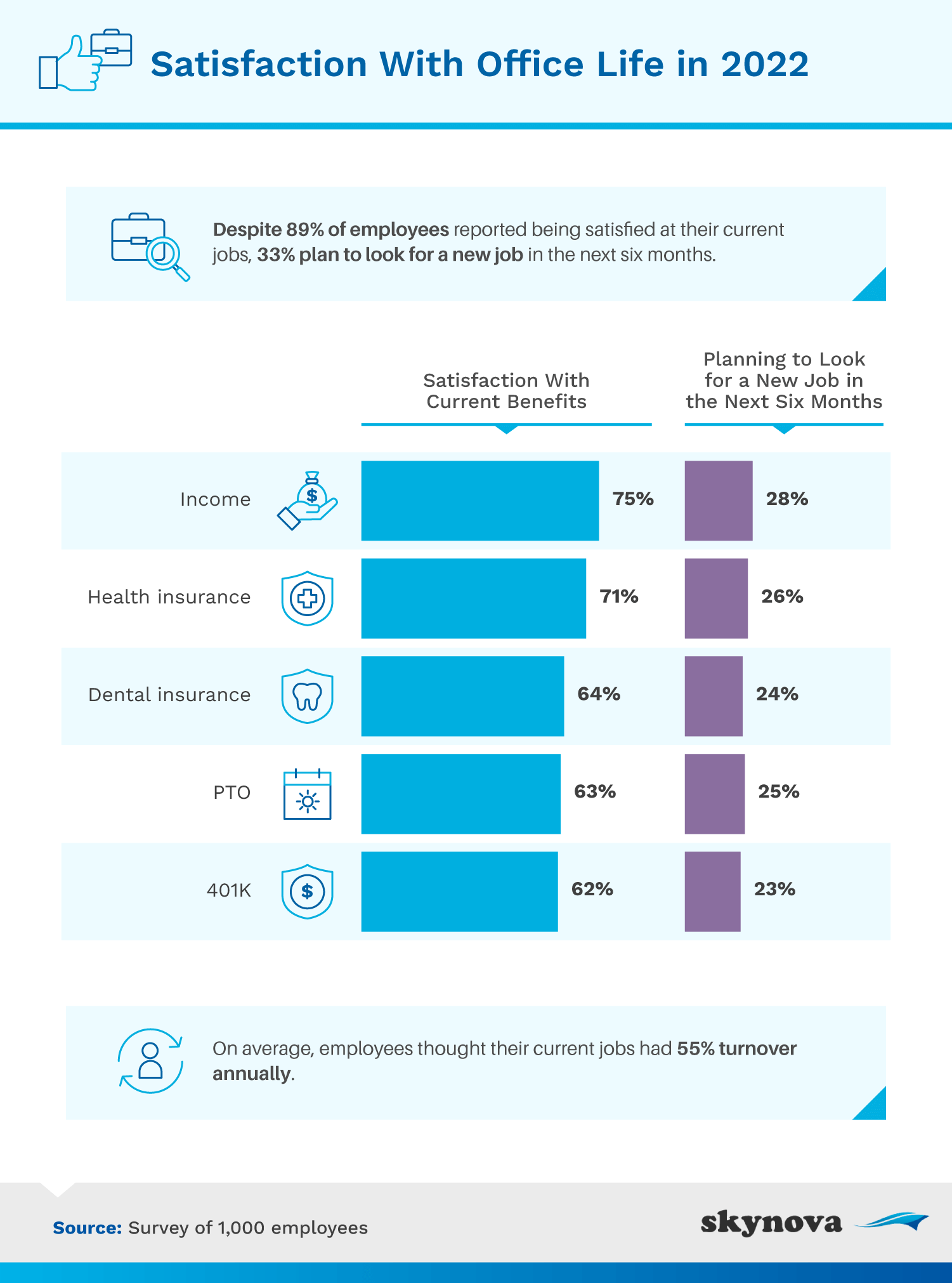
Overall, the majority of employees reported satisfaction with their jobs, and 3 in 4 workers were content with their current income. Employees also seemed pleased with their medical coverage, which could be due to health-related benefits often being the first thing employers improved because of the pandemic.
In terms of other traditional benefits, respondents were least likely to be satisfied with their retirement savings options such as their 401(k)s. Many Americans worry they won’t reach a level of financial security to retire comfortably when the time comes.
We also found, in spite of almost universal satisfaction with their current jobs, these feelings weren’t enough to prevent high levels of turnover. One-third of employees reported that they plan to start looking for new work within the next six months, and another 22% plan to search for a new position within the next year.
Some of this desire to change jobs may stem from a forced return to the office during a time when gas prices are soaring. Among surveyees, remote workers (58%) were much more likely than on-site workers (37%) to report extreme satisfaction with their positions. Many employees have also reported feeling like their bosses aren’t taking their feedback related to office returns seriously. There’s clearly a disconnect between workers and managers as more employees are seeking remote work and greater workday flexibility.
In the last two years many companies have successfully introduced a four-day workweek into their workplaces. This next analysis looks at how the concept of a four-day workweek might impact an employee’s tenure.
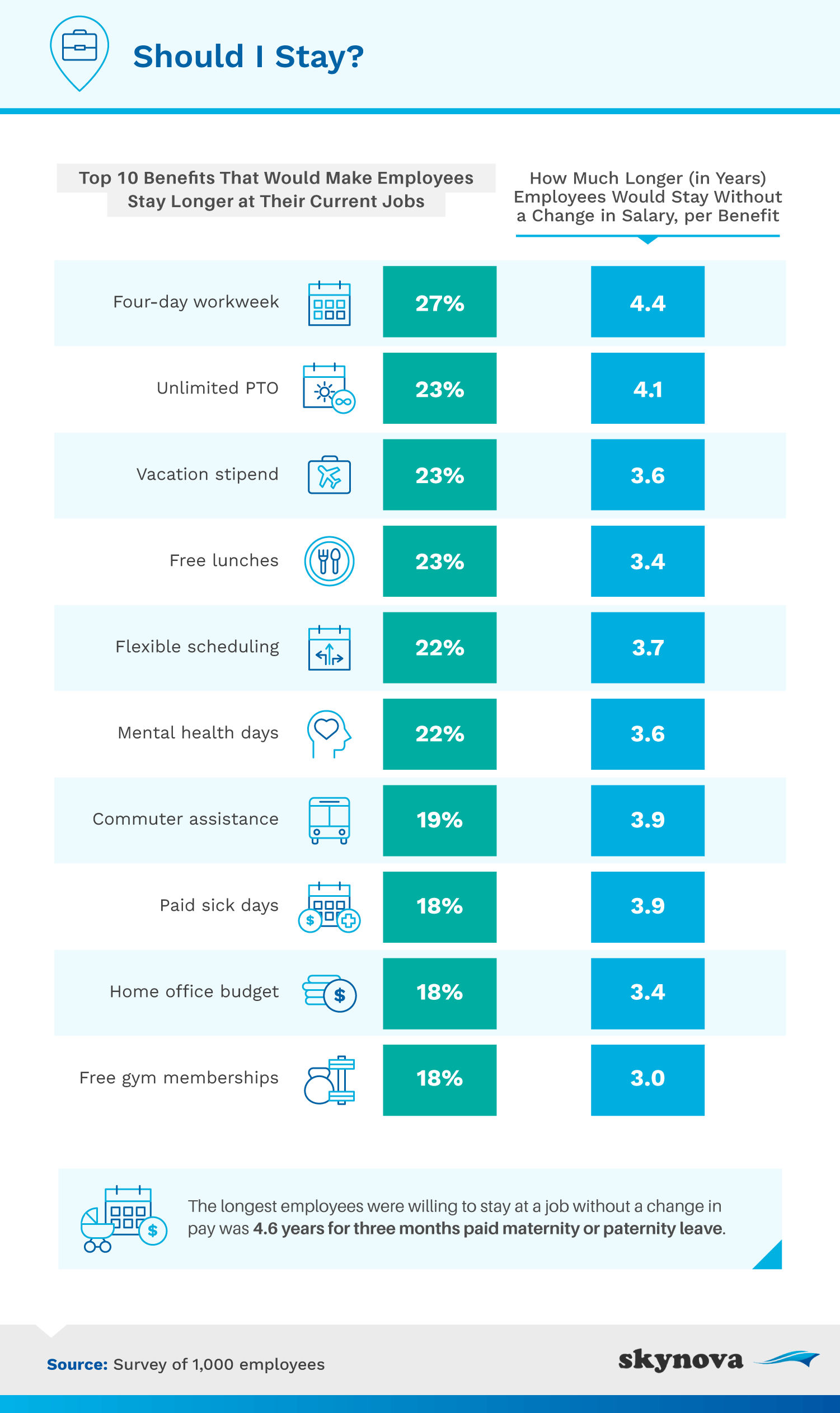
According to our study, a four-day workweek is the single-most effective way to encourage employees to stay longer at their current jobs. Even without a single salary increase, people would stay for an average of 4.4 more years at their roles for the chance to have a four-day workweek.
Some countries, like Iceland, have already implemented four-day workweeks and have found it to be an overwhelmingly successful venture. California has also recently introduced a bill aimed at reducing the workweek from 40 hours to 32 hours. Clearly, employees are already on board for this workplace change. Unlimited PTO was also compelling to some workers but not drastically more than vacation stipends or free lunches.
The longest a person was willing to stay without a change in job was 4.6 years if, and only if, they were offered three months paid maternity/paternity leave. Starting a family and raising children is expensive; however, there is no current federal legislation requiring employers to give employees any paid leave after the birth of a child. Instead, organizations with over 50 employees can offer the Family and Medical Leave Act (FMLA), which gives new parents 12 weeks of unpaid leave.
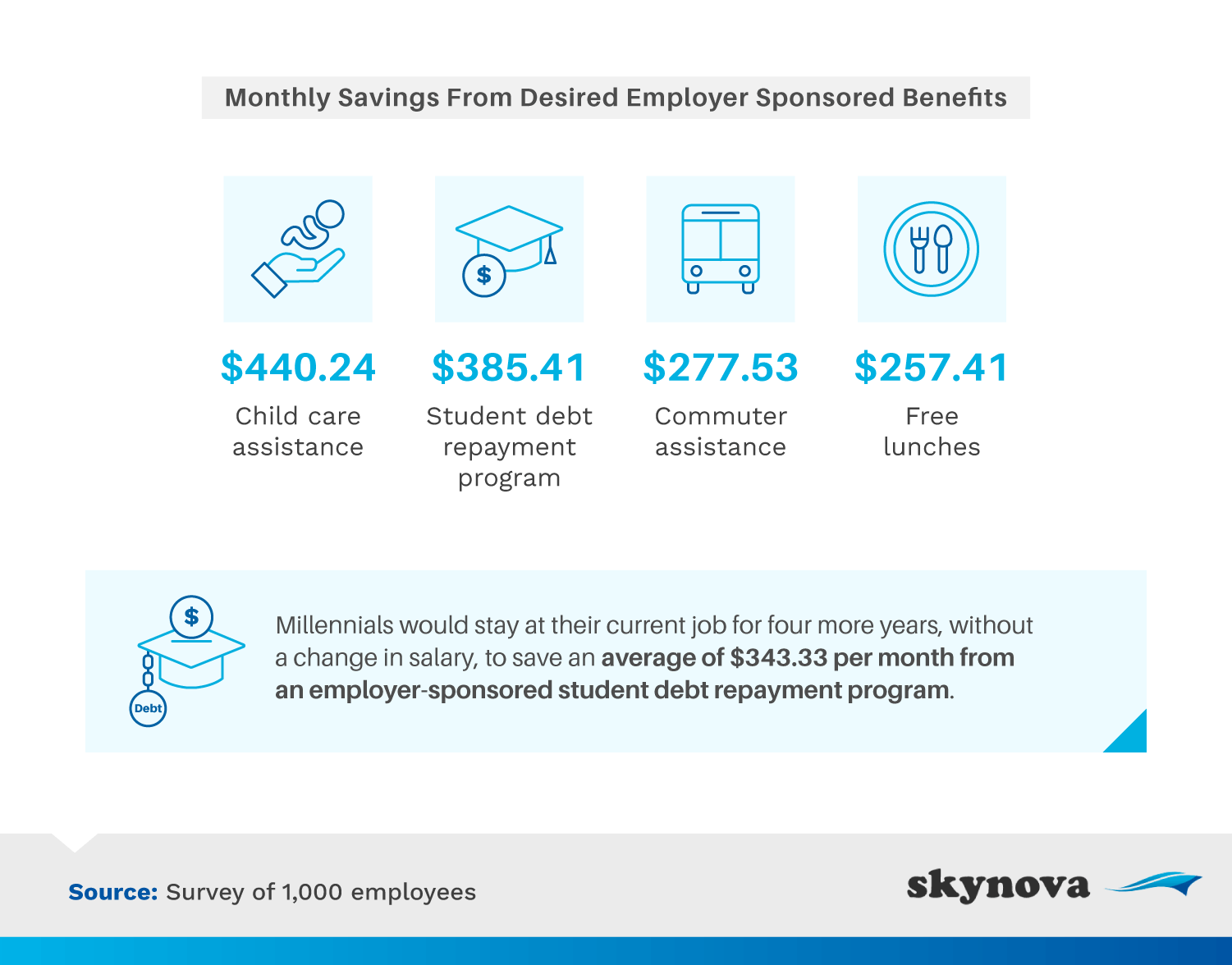
In the U.S. today, childcare costs an average of $10,000+ per year — an enormous chunk of the average American salary. Employees we surveyed hoped to save an average of $440.24 each month from employer-sponsored child care assistance.
Some companies already offer on-site child care, providing familial support directly in the office with much success. Considering how well this model works amidst the American backdrop of tenure issues and childcare demands, more companies may soon offer this benefit in order to retain current employees and attract new talent.
Millennials, however, were much more interested in student debt repayment programs than anything else. While the public has mostly been looking to the federal government to forgive these payments on a national scale, some employers are covering the charges as hiring competition gets tougher.
Even satisfied employees wanted to explore other options. This last piece of research asks respondents to share the top benefits from a new offer that would make them immediately leave their current roles.
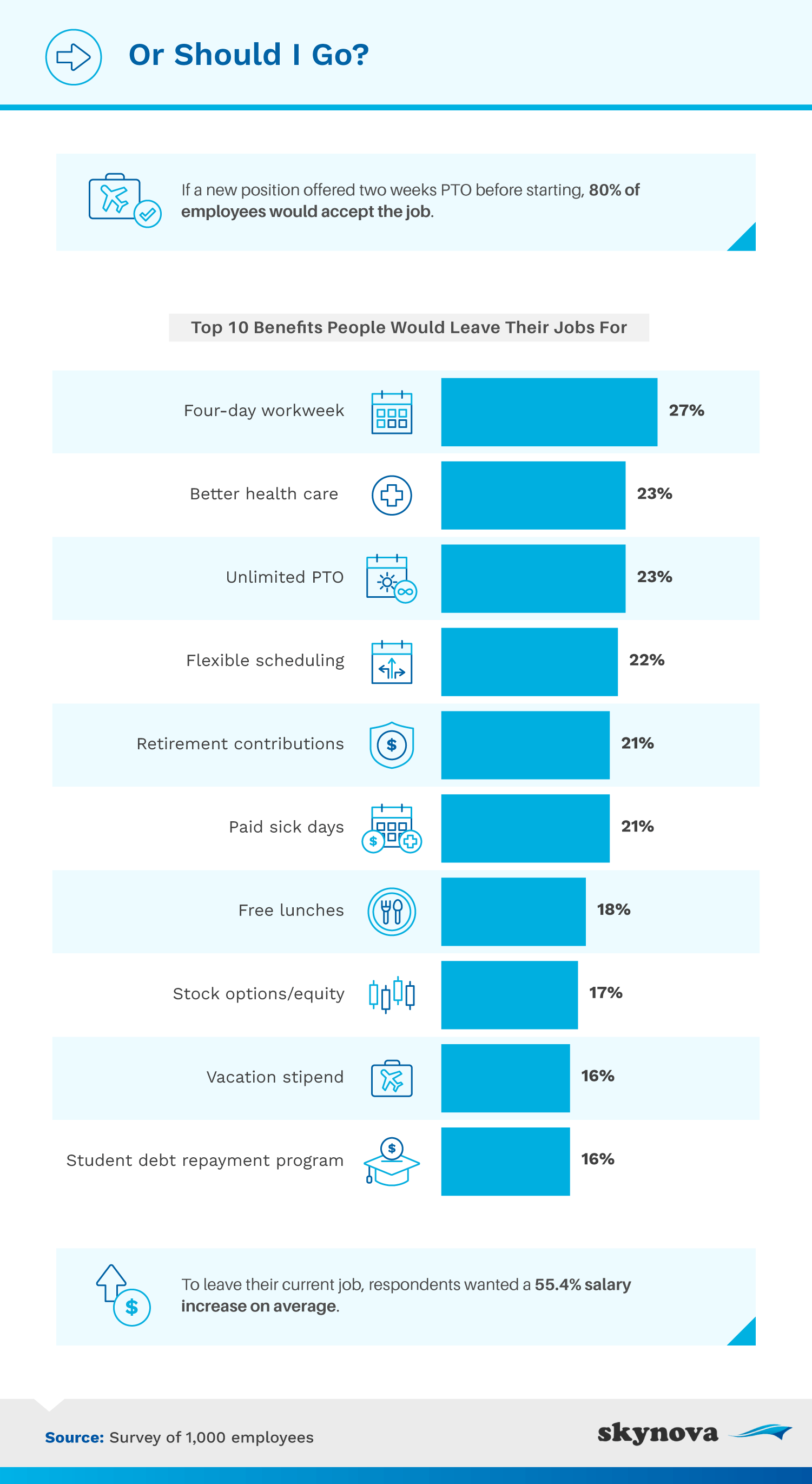
Pay has been the primary driver of job searches for years. Among the people we surveyed, the average salary increase they desired was 55.4%. For anything less, they were happy to stay in their current job.
In addition to better pay, respondents also appeared eager to have more time outside of work. The offer of a four-day workweek would have more than 1 in 4 employees immediately packing up their desks to accept an outside offer.
Respondents were also ready to have some free time right now. If an outside company offered two weeks of paid vacation prior to their first day, 80% of workers would quit and accept the offer. This option was much more popular than perks like better healthcare or unlimited PTO. Some tech companies have already begun experimenting with this process to help draw in new workers and reduce employee burnout.
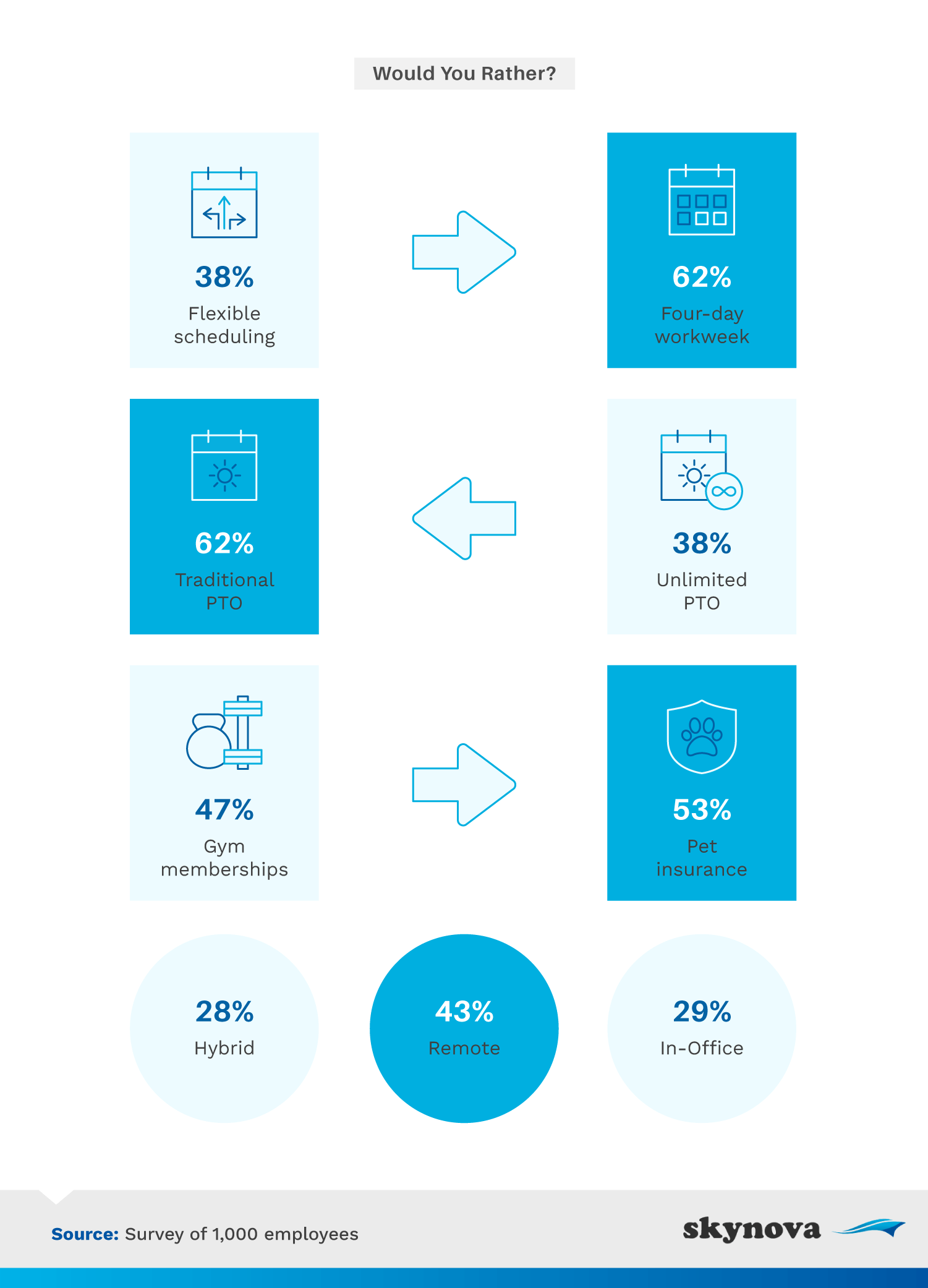
Even though flexible scheduling could theoretically create a four-day workweek, it was less desired than a mandatory four-day workweek. When directly compared, 62% chose a four-day workweek, while only 38% voted for flexible hours. This is similar to unlimited PTO vs traditional PTO; without counted and enforced vacation days, people with unlimited PTO policies often take the fewest vacation days of any workers in the U.S.
The evidence from our survey makes a strong case for the four-day workweek. Employees wanted this perk more than any other and were willing to stay at their current roles — without a salary increase — for more than four years just to enjoy a four-day workweek.
Fortunately for employers, current examples of companies with four-day workweeks appear highly successful. In industries where it is possible for employees to achieve the same results in fewer hours, this may heighten overall productivity, improve work-life balance, and reduce turnover.
Skynova helps small businesses get paid faster by simplifying and expediting the billing process. Skynova offers many different business templates and software modules to help you organize and grow your business.
Skynova surveyed 1,000 full-time employees about their job satisfaction and desired benefits. Respondents ranged in age from 19 to 76. By generation, 16% were baby boomers, 28% were Gen X, 36% were millennials, and 21% were Gen Z. This sample size contained a margin of error of +/-3% with a 95% confidence level. To help ensure accurate data, all respondents were required to identify and correctly answer a decoyed attention check question. Survey data has certain limitations related to self-reporting.
Financial security is more important than ever before and often goes hand in hand with employment. If you think someone in your audience can benefit from the findings of this employee survey, you’re welcome to share the research with them. Just be sure your purposes are noncommercial and that you provide a link back to this page.